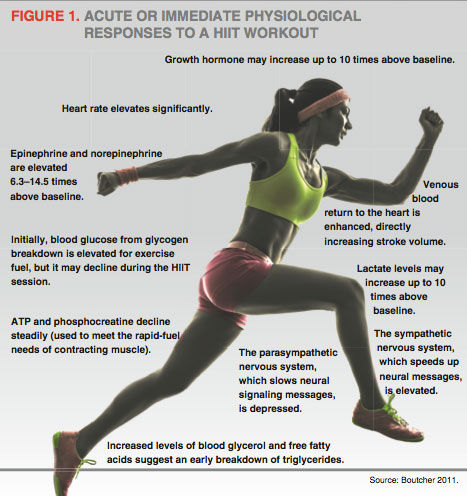
The Surprising Benefits of High-Intensity Interval Training (HIIT)
Written: Editor | July 6, 2023

Improved Cardiovascular Health
HIIT and its impact on heart health
As someone who is looking to ramp up your fitness routine, incorporating High-Intensity Interval Training (HIIT) into your workouts can be a game-changer for your cardiovascular health. HIIT involves short bursts of intense exercise followed by periods of active recovery. This form of training pushes your heart rate to its maximum capacity, improving overall heart health.
During HIIT workouts, your heart works harder to pump oxygenated blood to your muscles, increasing its strength and efficiency. This can lead to a decrease in resting heart rate and blood pressure, reducing the strain on your cardiovascular system.
Boosted endurance and increased VO2 max
One of the key benefits of HIIT is its ability to improve endurance and increase your VO2 max. VO2 max is a measure of how efficiently your body uses oxygen during physical activity. By engaging in HIIT regularly, you can enhance your body's ability to utilize oxygen, allowing you to exercise at higher intensities for longer durations.
HIIT workouts challenge your aerobic and anaerobic energy systems, increasing your stamina and tolerance to lactic acid buildup. This means that you can push yourself harder and longer during workouts, ultimately improving your overall endurance.
Reduced risk of heart disease
Engaging in regular HIIT workouts can also significantly reduce the risk of heart disease. Studies have shown that HIIT can improve various risk factors associated with heart disease, including cholesterol levels, blood pressure, and insulin sensitivity.
Furthermore, HIIT has been found to promote weight loss and decrease abdominal fat, both of which are linked to a reduced risk of heart disease. By incorporating HIIT into your fitness routine, you can take proactive steps towards maintaining a healthy heart and preventing cardiovascular conditions.
In conclusion, HIIT is not only a time-efficient exercise routine, but it also offers numerous benefits for your cardiovascular health. By pushing your limits and challenging your heart through intense bursts of exercise, you can improve heart strength, boost endurance, and reduce the risk of heart disease. So lace up your sneakers, embrace the intensity, and start reaping the rewards of HIIT for your heart health!

When it comes to achieving your weight loss and fat burning goals, incorporating high intensity interval training (HIIT) into your fitness routine can be a game changer. HIIT workouts are designed to push your body to its limits with short bursts of intense exercise followed by brief recovery periods. This efficient and intense training method offers numerous benefits that can help you shed pounds and melt away fat.
Effective calorie burn with HIIT
One of the main advantages of HIIT is its ability to maximize calorie burn in a short amount of time. Due to the high intensity nature of these workouts, you can torch calories at a faster rate compared to steady-state cardio exercises. Research shows that HIIT can burn up to 30% more calories than other forms of cardio training in the same time frame. This means that even if you only have 20-30 minutes to spare, a HIIT workout can provide a significant calorie burn.
Enhanced metabolism and fat oxidation
HIIT has been found to have a profound impact on your metabolism. The intense nature of these workouts causes your body to continue burning calories even after you have finished exercising. This phenomenon, known as excess post-exercise oxygen consumption (EPOC), results in an increased metabolic rate for several hours post-workout. Additionally, HIIT has been shown to enhance fat oxidation, which means that your body becomes more efficient at using stored fat as an energy source during and after exercise.
Combating obesity and promoting weight management
Numerous studies have highlighted the effectiveness of HIIT in combating obesity and promoting healthy weight management. HIIT has been shown to significantly reduce body fat percentage and abdominal fat. Furthermore, HIIT workouts have also been linked to improved insulin sensitivity, which can help regulate blood sugar levels and reduce the risk of developing type 2 diabetes. Incorporating regular HIIT sessions into your fitness routine can support long-term weight loss and help you maintain a healthy body weight.
In conclusion, if you are looking to achieve weight loss and fat burning goals, incorporating HIIT into your fitness routine can be highly beneficial. With its ability to maximize calorie burn, enhance metabolism, and promote weight management, HIIT offers a time-efficient and effective solution for achieving your desired results. Remember to consult with a fitness professional before starting any new exercise program to ensure it is safe and appropriate for your individual needs

Increased Muscle Tone and Strength
Muscle building and development with HIIT
Are you looking for a workout routine that can help you achieve your fitness goals efficiently? High-Intensity Interval Training (HIIT) might be the answer! This form of exercise involves short bursts of intense activity followed by periods of rest or lower intensity exercise. It is known for its effectiveness in boosting muscle tone and strength.
Anaerobic and resistance training benefits
One of the key benefits of HIIT is its ability to engage both anaerobic and resistance training. The intense bursts of exercise during HIIT sessions push your muscles to work at their maximum capacity. This stimulates the growth and development of muscle fibers, resulting in increased muscle tone and strength. Additionally, the resistance exercises included in HIIT routines, such as bodyweight exercises or weightlifting, further contribute to muscle building and strength gains.
Improved muscle definition and body composition
Not only does HIIT help you build and tone your muscles, but it can also improve your overall body composition. By engaging in these high-intensity workouts, you can increase your lean muscle mass while reducing body fat. This combination leads to improved muscle definition and a more sculpted physique. HIIT has been shown to be especially effective at targeting stubborn areas of fat, such as the abdomen and hips.
In summary, here are the key benefits of HIIT for increasing muscle tone and strength:
- Engages both anaerobic and resistance training, stimulating muscle growth and development.
- Includes resistance exercises that further contribute to muscle building and strength gains.
- Improves overall body composition by increasing lean muscle mass and reducing body fat.
- Targets stubborn areas of fat, resulting in improved muscle definition and a more sculpted physique.
If you're looking to enhance your muscle tone, strength, and overall body composition, incorporating HIIT into your fitness routine could be just what you need.

Time Efficiency and Convenience
HIIT as a time-saving workout option
When it comes to getting in shape, time is often a limiting factor. This is where High-Intensity Interval Training (HIIT) comes to the rescue. HIIT workouts are designed to be short but intense, making them perfect for busy individuals who want to maximize their time. With HIIT, you can achieve the same or even better results compared to longer, steady-state cardio workouts in a fraction of the time. By combining bursts of high-intensity exercise with short periods of rest, you can burn calories, increase your cardiovascular fitness, and build muscle in as little as 20 minutes per session.
No equipment needed for HIIT
Another major advantage of HIIT is that it can be done without any expensive or fancy equipment. Unlike traditional gym workouts that often require various machines and weights, HIIT workouts rely on bodyweight exercises and simple movements such as squats, lunges, and push-ups. This makes HIIT a convenient option for those who prefer to exercise at home or while traveling. All you need is some space and a can-do attitude.
Flexibility to fit into busy schedules
Finding time to exercise can be tough, especially if you have a hectic schedule. The beauty of HIIT is its flexibility to fit into even the busiest of schedules. Whether you have 10 minutes in the morning or 30 minutes during lunch break, HIIT can be tailored to your available time. You can choose the length and intensity of your sessions based on what works best for you. Furthermore, HIIT can be done anywhere, anytime, making it easy to incorporate into your daily routine.
In conclusion, HIIT workouts offer several benefits that make them an attractive option for time-conscious individuals seeking an efficient and convenient way to exercise. With no equipment necessary and the flexibility to fit into busy schedules, HIIT allows you to burn calories, improve fitness, and build muscle in a short amount of time. So, why not give HIIT a try and experience the benefits for yourself?

Mental Health and Cognitive Benefits
HIIT and stress reduction
If you've been looking for an effective way to reduce stress, look no further than high intensity interval training (HIIT). Studies have shown that engaging in HIIT workouts can significantly lower levels of stress hormones like cortisol. The intense bursts of exercise followed by short recovery periods help release endorphins, which are known as “feel-good” hormones that can counteract the effects of stress. Adding HIIT to your routine can provide a much-needed outlet for stress relief and leave you feeling more relaxed and in control.
Improved mood and mental well-being
In addition to reducing stress, HIIT workouts can also have a positive impact on your overall mood and mental well-being. The intense physical exertion and release of endorphins during HIIT workouts can lead to a natural “runner's high,” leaving you feeling happier and more energized. Regularly incorporating HIIT into your fitness routine can help combat feelings of depression and anxiety, promote feelings of positivity, and boost your overall mental well-being.
Enhanced cognitive function and memory
Did you know that HIIT workouts can also benefit your brain? Research has shown that HIIT can improve cognitive function and memory. The increased blood flow and oxygen delivery to the brain during high-intensity exercises can enhance cognitive abilities such as concentration, focus, and problem-solving skills. Additionally, HIIT has been found to stimulate the production of a protein called brain-derived neurotrophic factor (BDNF), which plays a key role in supporting the growth and maintenance of brain cells. By incorporating regular HIIT workouts into your routine, you can sharpen your mind and boost your cognitive abilities.
So, whether you're looking to reduce stress, improve your mood, or enhance your cognitive function and memory, high intensity interval training (HIIT) can offer a range of mental health benefits. Consider adding HIIT workouts to your fitness regimen and start reaping the rewards for your mind and body.

Conclusion
In conclusion, high intensity interval training (HIIT) offers numerous benefits for individuals looking to maximize their workouts. From improving cardiovascular fitness to burning calories quickly and efficiently, HIIT is a time-efficient and effective form of exercise.
Summary of HIIT benefits
Here is a summary of the key benefits of HIIT:
- Increased calorie burn: HIIT workouts can help you burn calories long after your workout is over, thanks to the afterburn effect.
- Improved cardiovascular fitness: HIIT exercises challenge your cardiovascular system, improving your heart health and endurance.
- Time efficiency: HIIT workouts typically last for a shorter duration but provide the same, if not greater, benefits compared to longer, moderate-intensity workouts.
- Increased metabolism: The intense nature of HIIT workouts can help boost your metabolism, allowing you to burn more calories throughout the day.
- Fat loss: HIIT has been shown to be effective in reducing body fat and losing weight, especially when combined with a healthy diet.
Tips for incorporating HIIT into your exercise routine
If you are interested in incorporating HIIT into your exercise routine, here are some tips to get you started:
- Start slowly: If you are new to HIIT, start with shorter intervals and lower intensity exercises. Gradually increase the intensity and duration as your fitness level improves.
- Choose exercises you enjoy: HIIT can be done with various exercises such as running, cycling, bodyweight exercises, or using gym equipment. Pick exercises that you enjoy and are comfortable with.
- Mix it up: Change your HIIT routine regularly to keep it challenging and prevent boredom. Try different exercises, intervals, and workout formats to keep things interesting.
- Listen to your body: HIIT is intense, so it's important to listen to your body and give yourself rest days to recover. Don't push yourself too hard and remember to prioritize proper form and technique.
- Consult a professional: If you are new to exercise or have any medical conditions, it is always advisable to consult a fitness professional before starting any new workout program.
Frequently Asked Questions
Q: Can anyone do HIIT?
A: HIIT can be modified for various fitness levels, but it is advisable to consult a healthcare professional before starting any new exercise program, especially if you have any underlying health conditions.
Q: How often should I do HIIT?
A: The frequency of HIIT workouts depends on your fitness level and goals. Start with 2-3 sessions per week and gradually increase as your fitness improves.
Q: How long should a HIIT workout be?A: HIIT workouts can vary in duration, but they typically range from 10 to 30 minutes, including warm-up and cool-down periods.
Q: Can I do HIIT if I am not in good shape?A: HIIT can be modified to suit different fitness levels. Start with shorter intervals and lower intensity exercises, gradually increasing as your fitness improves.
Remember, consistency is key when it comes to seeing results from any exercise program. Always listen to your body, stay hydrated, and enjoy the benefits of HIIT!



